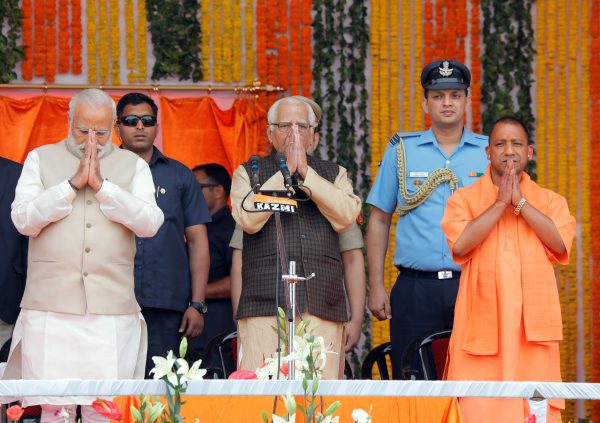When the elections were over, incumbent governments had been unseated or suffered severe losses in every state. Regional parties suffered severe losses while the once dominant Indian National Congress (INC) was hardly treading water.
s
The BJP won large majorities in UP and Uttarakhand, displacing a regional ally of the INC and the INC itself respectively. The INC in turn won convincingly in Punjab, displacing a BJP ally. A BJP government in Goa and INC government in Manipur both lost their majorities, but both states produced hung legislatures with INC in first place and BJP in second.
A birds’ eye view of the results suggests there were two factors at work: anti-incumbent sentiment and a polarisation of the electorate at the expense of regional parties. The decline of regional parties in UP is especially significant. Two parties championing disadvantaged caste clusters, the Samajwadi Party (SP) and Bahujan Samaj Party (BSP), have taken turns ruling UP since 2002. Both saw their vote shares drop to around 20 per cent of the electorate and their representation in the legislature shrink precipitously.
In both cases their decline was due in part to conflicts in their core constituency that the BJP exploited. The SP’s core constituency of relatively disadvantaged peasant communities known as ‘Other Backward Classes’ was dominated by the Yadav community. So was the BSP’s core constituency, the traditionally most marginalised communities collectively known as ‘Dalits’, by the Jatavs.
But this birds’ eye view only tells part of the story.
UP is far larger than the other states. The BJP’s landslide victory there wiped out the ruling party’s embarrassing loss in neighbouring Bihar in 2016. It also put to rest concerns that the Prime Minister’s controversial decision to replace two thirds of India’s currency, at great cost to the poor, would prove costly at the ballot box. Moreover, the party increased its share of the vote in every state except Goa, while the INC’s vote share declined everywhere except Punjab.
The biggest story came after the votes were counted, when internal divisions in the major parties took centre stage.
The INC’s continuing organisational and strategic paralysis prevented it from forming governments in Manipur and Goa, despite being the largest party. The BJP moved quickly to secure promises of support from minor parties, and BJP-appointed governors in the two states then invited the BJP to form a government. In both these states and in Uttarakhand, the BJP’s gains came partly by capitalising on factional battles within the INC, as defections from the latter swelled the BJP’s ranks.
In UP, where the BJP won without identifying ahead of the election who would lead its government, Prime Minister Narendra Modi was given a free hand to select the chief minister.
But Modi’s choice of Yogi Adityanath for the role might indicate a strategic and organisational failing of its own. In 2015 a video appeared showing a speaker at a north Indian political rally calling on young men to dig up the graves of Muslim women to rape their corpses. Seated on the same stage was Yogi Adityanath, head of a large religious endowment, founder of a militant youth organisation for Hindus, and member of India’s parliament for 20 years. On 20 March 2017 Adityanath, who has made many anti-Muslim statements himself, was sworn in as the chief minister of India’s largest state, whose population of 200 million is nearly 20 per cent Muslim.
The BJP’s failure to project a chief ministerial candidate reflected factional battles in UP, where large caste clusters continue to form the building blocks of electoral coalitions. The BJP’s core constituencies in the state come from elite Hindu castes and two of these — Brahmins (priests and literati) and Thakurs (landowners) — were seen as especially anxious to win control of the chief ministership.
Adityanath — a Thakur-turned-cleric — was paired with two deputy chief ministers, one a Brahmin and the other a member of the Other Backward Class cluster that had previously been the SP’s domain. The choice of Adityanath himself was widely seen as representing not so much a concession to Thakurs as an effort to supersede caste divisions by heightening religious divisions in the state to consolidate the Hindu vote.
Concerns about the implications of a Hindu consolidation strategy have led many to view Adityanath’s ascension with alarm.
The BJP’s rise since the late 1980s, from a relatively small party in the Hindi-speaking north to a contender for national power, has been marked by episodes of sectarian mobilisation that polarised voters in certain parts of the country around religious identity. These include a movement that culminated in the destruction of a mosque in Ayodhya in 1992 and a massive anti-Muslim pogrom in Gujarat state in 2002, when Modi was chief minister.
Since Modi became prime minister in 2014, UP has experienced several instances of Muslims being lynched for allegedly eating beef and other provocative acts toward Muslims. Although the BJP’s campaign did not emphasise sectarian issues, Adityanath’s selection seems to many to be a massive bet that the way to victory in 2019 is to do whatever is necessary to consolidate anti-Muslim sentiment among Hindus in order to overcome their divisions along caste lines.
Arun Swamy is Associate Professor of Political Science, University of Guam.

